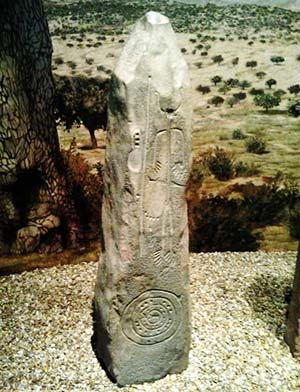Bronze Age History
Early Bronze
 The centre of Bronze Age technology was in the southeast since circa 1800 BC. There the civilisation of Los Millares was followed by that of El Argar, initially with no other discontinuity than the displacement of the main urban centre some kilometres to the north, the gradual appearance of true bronze and arsenical bronze tools and some greater geographical extension. The Argarian people lived in rather large fortified towns or cities.
The centre of Bronze Age technology was in the southeast since circa 1800 BC. There the civilisation of Los Millares was followed by that of El Argar, initially with no other discontinuity than the displacement of the main urban centre some kilometres to the north, the gradual appearance of true bronze and arsenical bronze tools and some greater geographical extension. The Argarian people lived in rather large fortified towns or cities.
From this center, bronze technology spread to other areas. Most notable are:
- Bronze of Levante: in the Valencian Community. Their towns were smaller and show intense interaction with their neighbours of El Argar.
- South-Western Iberian Bronze: in southern Portugal and SW Spain. These poorly defined archaeological horizons show the presence of bronze daggers and an expansive trend in northwards direction.
- Cogotas I culture (Cogotas II is Iron Age Celtic): the pastoralist peoples of the plateau become for the first time culturally unified. Their typical artifact is a rough troncoconic pottery.
Some areas like the civilization of Vila Nova seem to have remained apart from the spread of bronze metallurgy remaining technically in the Chalcolithic period for centuries.
Middle Bronze
This period is basically a continuation of the previous one. The most noticeable change happens in the El Argar civilisation, which adopts the Aegean custom of burial in pithoi. This phase is known as El Argar B, beginning circa. 1500 BC.
The North-West (Galicia and northern Portugal), a region that held some of the largest reserves of tin (needed to make true bronze) in Western Eurasia, became a focus for mining, incorporating then the bronze technology. Their typical artifacts are bronze axes (Group of Montelavar).
The semi-desert region of La Mancha shows its first signs of colonisation with the fortified scheme of the Motillas (hill forts). This group is clearly related to the Bronze of Levante, showing the same material culture.
Late Bronze
Circa. 1300 BC several major changes happen in Iberia, among them:
- The Chalcolithic culture of Vila Nova vanishes, possibly in direct relation to the silting of the canal connecting the main city Zambujal with the sea. It is replaced by a non-urban culture, whose main artefact is an externally burnished pottery.
- El Argar also disappears as such, what had been a very homogeneous culture, a centralized state for some, becomes an array of many post-Argaric fortified cities.
- The Motillas are abandoned.
- The proto-Celtic Urnfield culture appears in the North-East, conquering all Catalonia and some neighbouring areas.
- The Lower Guadalquivir valley shows its first clearly differentiated culture, defined by internally burnished pottery. This group might have some relation with the semi-historical, yet-to-be-found, Tartessos.
- Western Iberian Bronze cultures show some degree of interaction, not just among them but also with other Atlantic cultures in Britain, France and elsewhere. This has been called the Atlantic Bronze complex.

